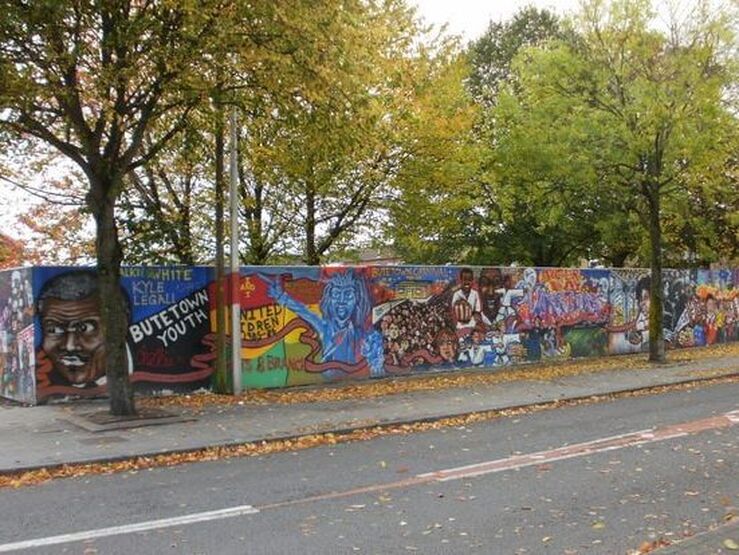|
|
|
The Facebook group for my local area in Manchester generally has messages about missing cats and people looking for recommendations for plumbers. But there are also messages asking ‘what is it like to live in the area’ from people thinking of moving there. This is a very ethnically mixed, relatively deprived area which has an equally mixed reputation. The responses to the queries often refer to reputational issues – and ones of history, suggesting that the area has/has not changed over time. The live nature of histories of place and the ways in which stories about places are frequently racialized is what colleagues and I were concerned with in our recent Identities article, ‘Histories of place: the racialization of representational space in Govanhill and Butetown’. We were interested in considering the racialized nature of Henri Lefebvre’s[1] conceptualizations of spatial tactics, representations of space and representational space – including in the way they are marked by the past.
We examined interviews with local activists, community representatives and professionals working in the areas of Butetown in Cardiff and Govanhill in Glasgow which were part of a study of the dynamics of ethnic inequalities for the Centre on the Dynamics of Ethnicity (CoDE). Both areas have long histories of immigration and, as representational spaces, have often been highly racialized. They have been shaped by industrialization, empire, de-industrialization and then some subsequent regeneration.
Govanhill grew up around the ‘Dixon Blazes’, the Govan Iron Works that attracted both the rural Scottish and new migrant communities to settle and work there. These included Irish, Jewish, Italian, and Pakistani communities living in tenements built to house the industrial labour force, with this history of their arrival often being described in ‘waves’ which finally end with the more recent settlement of Roma from Slovakia and Romania from the 1990s onwards.
Butetown (previously known as Tiger Bay) has a clear status in both local and wider discourses as a place with a highly racialized history characterized by a long (pre-Windrush) history of non-white settlement centred around the docks, a key route for the export of Welsh coal and a long history of inter-racial marriage and mixing. Global seafarers (particularly from Somalia and the Yemen) and others coming to work in the coal industries settled in the area including from the Caribbean, Norway, Spain, Italy, Ireland, and West Africa. In more recent times, Butetown was a place of refugee settlement and also experienced large-scale regeneration on its doorstep in the development of the Cardiff Bay area from the late 1980s, also involving a ‘rebranding’ of the area. In both areas we see the presence – and contestation – of nostalgic accounts of the past. Tiger Bay was remembered, particularly by older residents, as an area which had been stigmatized but which also provided a haven against the racism experienced in the rest of Cardiff or Wales – where the racial mixing meant that everyone was ‘a mixture of everyone else’. This was sometimes contrasted with what was seemed as a more segregated present where different ethnic groups led more separate lives. However, these accounts failed to recognize the very different economic contexts in which social and spatial practices emerged. The nostalgic accounts were also contested by younger respondents who countered that social mixing was common among the young, just in different spaces. Similar nostalgia about the past was shaping campaigns in Govanhill in 2014-15 which used concerns about fly-tipping and rubbish to express hostility to the Eastern European and particularly Roma living in the area. Yet our respondents also questioned these accounts by drawing on the areas much longer history of migration – suggesting that the area had always been shaped by new arrivals – including from rural Scotland and Ireland. In an era of increasing interest around local history, these examples show some of the pitfalls of nostalgia around the past. Nostalgic narratives of space and community have the potential to position newer migrants as outsiders in ways which can heighten racialized tensions. Yet at the same time, listening to the accounts of local activists and community representatives can also point to how these narratives can be contested. They can also show how local narratives need to be set in the context of global flows, networks and economic relations which powerfully shape local areas. [1] Henri Lefebvre, 1991, The Production of Space Oxford, Blackwell
Blog post by Bridget Byrne, Centre on the Dynamics of Ethnicity, University of Manchester, UK
Read the Identities article: Byrne, Bridget, Garratt, L., Harries, B. and Smith, A. Histories of place: the racialization of representational space in Govanhill and Butetown. Identities: Global Studies in Culture and Power. DOI: 10.1080/1070289X.2022.2099119 OPEN ACCESS
Read further in Identities:
Place as social identity: an analysis of the spatial enactments of community loss and activism within the built environment surrounding Grenfell Tower The racialisation of asylum in provincial England: class, place and whiteness “Diversity” on Main Street? Branding Race and Place in the New “Majority-Minority” Suburbs Comments are closed.
|
|
Explore Identities at tandfonline.com/GIDE |
|
The views and opinions expressed on The Identities Blog are solely those of the original blog post authors, and not of the journal, Taylor & Francis Group or the University of Glasgow.


